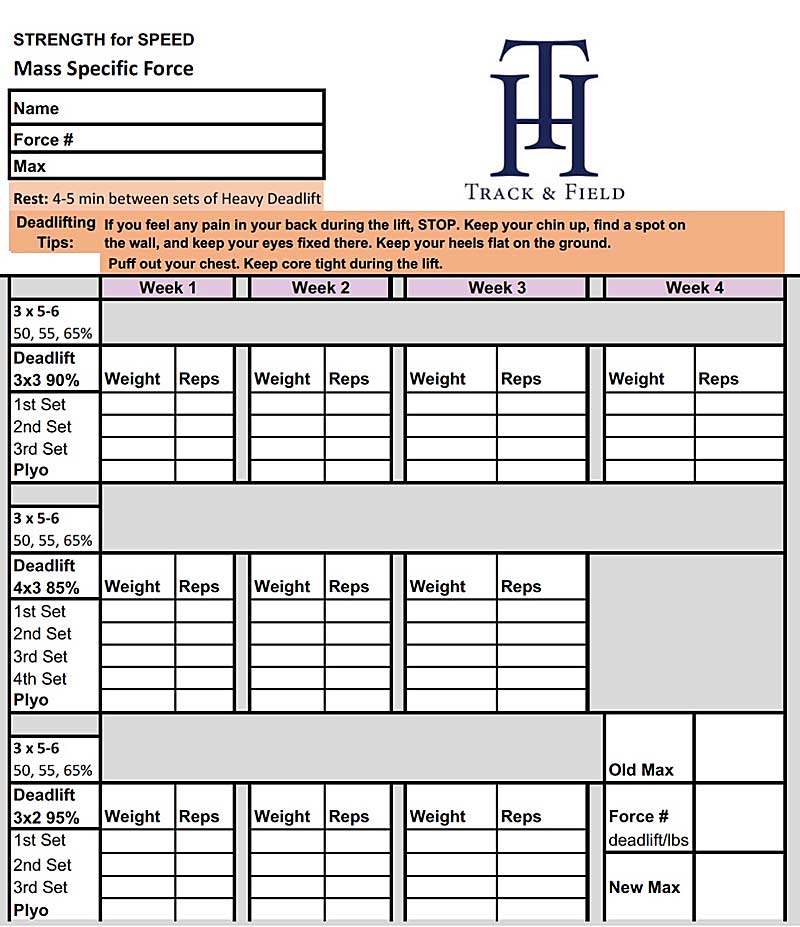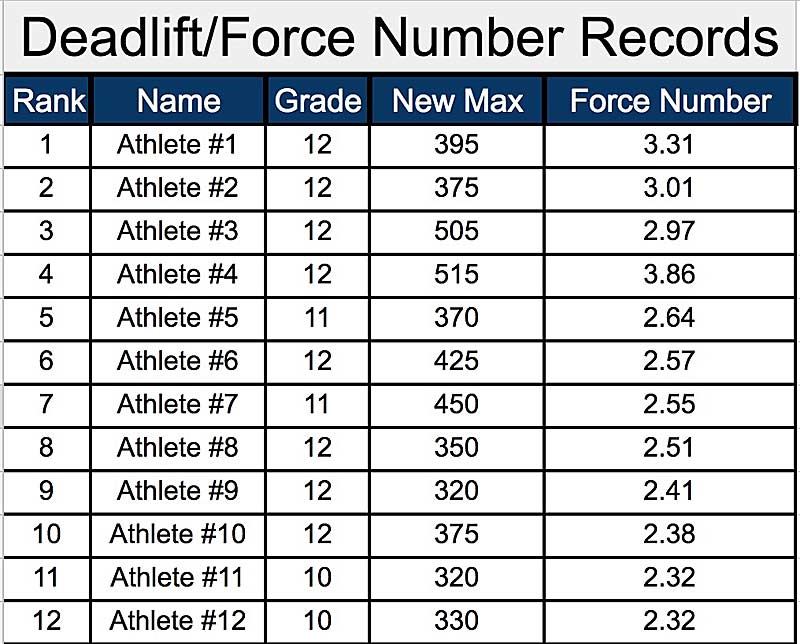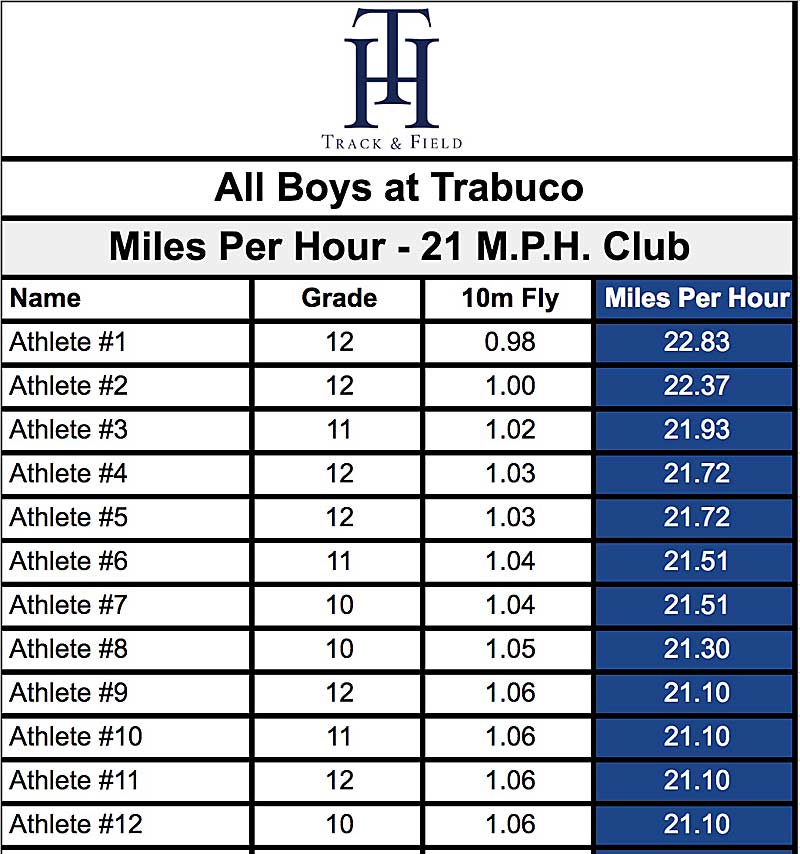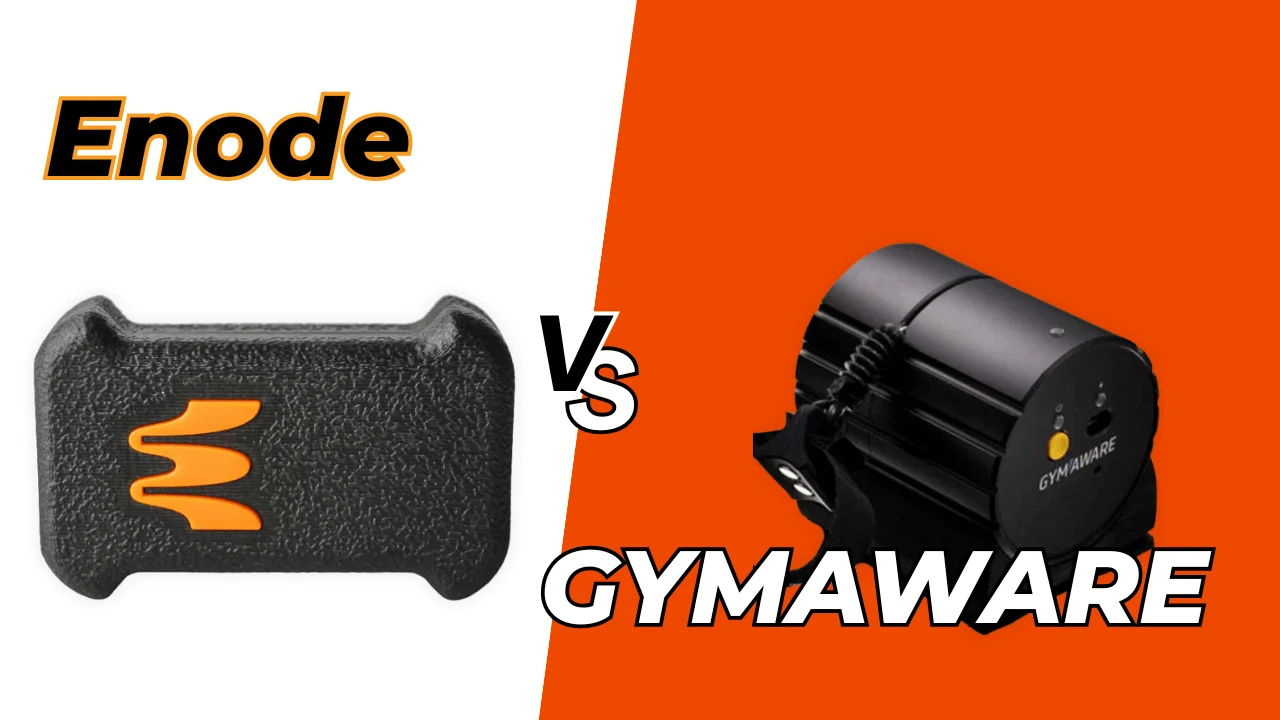[mashshare]
Track athletes want to run faster. As a track coach, I really want all my kids to run faster. However, it seems we often hear the same excuse from coaches, parents, and athletes: some kids are born fast, and some are not.
I haven’t found this to be true. Yes, some athletes are born with a genetic predisposition to run faster than others. Speed, however, is a skill and we can teach it. Acceleration and running workouts designed for speed are very important, but so is the weight room. That being said, this article is about how to lift for speed.
Mass Specific Force (MSF): The Amount of Force Applied in Relation to Bodyweight or Mass
“Faster top running speeds are achieved with greater ground forces not more rapid leg movements”—Barry Ross
(Be sure to check out Barry Ross’ fantastic book, Underground Secrets to Faster Running. It’s hard to find but worth the read).
There are three components for speed:
- How often you contact the ground
- How much muscular force you can deliver during ground contact
- How much ground contact time is available to deliver that force
When combined, these three factors dramatically impact stride length and stride rate (frequency). The ability to generate and transmit muscular force to the ground is why someone runs fast. You want to encourage this in all your training efforts. In the weight room, the goal is to get strong without adding mass. It might be the only time in the weight room when “swole is not the goal and size is not the prize.”
To break it down in very simple terms, when you add more mass, you add more gravitational pull. Someone who wants to run faster needs to focus their weight room efforts on lifting with the right exercises so they don’t add mass. Instead, they want to specifically increase the strength of the muscles called upon to apply as much force to the ground as possible.
If you add mass (weight) to your body, the amount of force applied to the ground must increase proportionately to maintain the same rate of speed.
Physiology: Muscle Fibers
There are three types of major muscle fibers:
- Type 1: slow twitch or slow oxidative—respond best to lighter training weights and a higher number of reps. Type 1 fibers are aerobic because they’re fueled by oxygen.
- Type 2: fast twitch oxidative—both aerobic and anaerobic and used in all activities.
- Type 3: fast twitch glycolytic—maximum force production fibers and largest potential to increase in size and strength. This is sprinting. These fibers are largely anaerobic. Those who want to increase their speed want this.
How do we increase type 3 muscle fibers?
Lift heavy often. This will increase your myofibrils, also called myofibrillar hypertrophy. The goal of the sprinter in the weight room is strength without mass. We find our one rep max (1RM), then work off that. Greater strength allows the athlete to run with greater economy since less energy is required to move the athlete’s mass.
Physiology: Rest
In the weight room, stay away from the burn that comes with extra reps—this is good for a bodybuilder but not a sprinter. The burn stems from lactic acid, which builds mass in addition to strength.
How do we program rest?
It is important to spend five minutes resting between sets because the phosphagen pool regenerates in a relatively short period of time—this is crucial to the creation of significant strength with minimal mass.
Athletes' muscles must be completely idle during the rest period. Our athletes sit and wait, says @coachjtayers. Share on XFor the phosphagen pool to adequately regenerate, it’s imperative that the athlete’s leg muscles are completely idle during this rest period. Our athletes will sit on the ground and wait. The rest period results in the athlete experiencing little-to-no muscle fatigue (from lifting) in the subsequent hours or days. To keep track of their rest, we have a clock on the wall, or they can use the timer on their cell phones.
The Weight Room Workout
A sprinter could incorporate as many as three sessions (heavy weight with low reps) per week since they do not work muscles to exhaustion and both lactic acid production and the need to rebuild muscle fiber are minimal. We strive for three lifts per week (Monday, Wednesday, Friday) in the off-season; however, with teenagers’ schedules, we’ll settle for two. In season, we continue to lift two times per week until the competition phase, when we move it to one.
You can lift all season when you do it intentionally for #speed, says @coachjtayers. Share on XA few years ago, one of the top hurdlers in the state lifted the Monday before the state championship. When Allyson Felix was in high school, she maxed on May 3 and then ran the best race of her life May 5. You can lift all season when you do it intentionally for speed! (See Why In-Season High-Intensity Strength Work Is Better Than Maintenance Programs)
Our weight-training goal for speed is superior strength with minimal additional mass, says @coachjtayers. Share on XOur weight-training goal is to create superior strength in the right muscles with minimal additional mass—not to increase muscle size. The only way to maximize MSF is through a high-weight, low-rep, and long-rest routine.
In summary, in every sport that requires running or jumping, we must offset the effect of gravity. Increasing MSF helps offset gravity.
Fall in Love with the Deadlift
We deadlift. There are many benefits to the deadlift when lifting for speed.
Muscles involved in deadlift:
- Quads
- Glutes
- Hamstrings
- Abdominals
- Calves
- Lower Back
- Trapezius
- Latissimus dorsi
- Scapular retractors
We also use Hexagon deadlift bars, where athletes step into the bar. We’ve found this helps a great deal with form. Note: it is very important that no athletes deadlift with heavy weight until they can deadlift with perfect form using light weight.

Benefits of the deadlift, especially with a Hexagon deadlift bar, include:
- Limb speed improves more by lifting heavy weight, not by moving lighter weight faster.
- The weight moves slowly, but the motor units fire as fast as they can.
- By limiting reps to no more than 5 in a set at 85-100% of max with a 5-minute rest, the regeneration of the phosphagen pool can perform at 95% capacity after 5 minutes and then at 95% of each succeeding set.
Rest by sitting down.
The movement that we utilize in the deadlift is concentric (the up movement), where we build explosiveness and not mass, and we skip the eccentric movement (the down movement) where we build mass. This means the athlete will push up with the bar and drop it at the top.
After each set of deadlifts, we add single leg stabilization (really works the athlete’s core) and a plyometric. Plyos include box jumps, depth jumps, tuck jumps, and rocket jumps. If an athlete fails to complete the rep in any set, that becomes their new 1RM. If the lift begins to stall, where there is no movement for more than 2-3 seconds, abort immediately or drop the weight.
Here is an example of a great 60-minute workout.
- Dynamic stretching and warm up
- Deadlift warm-up: 3 sets at 50%, 55%, 65% of max (2 reps each set)—use the eccentric and concentric movements or go up and down with the bar
- Deadlift (followed by plyo immediately after each set, then sitting rest)—drop bar immediately upon completion of each rep and do not raise your shoulders or hyperextend your back
- Core and single stabilizing exercises circuit
- Push-ups
- Static stretching
Force Number Formula
Strength training in the weight room is the best method to increase MSF. We use this to encourage our athletes to increase their strength while not attempting to gain weight. So the next time another coach at your school tells one of your students they need to gain weight, have your athletes ask them about the science behind that statement.
Our Force Number Formula: Take their deadlift and divide by their weight.
For example, Jared F. deadlifted 395 and weighed 119lbs: his force number was 3.31. That’s the highest I’ve ever coached. Anything above 3 is insane. Most varsity male sprinters will need to be around 2.5 or above.

Force number is not a clear indication of the amount of force your athlete can generate and put into the ground based on their weight, but it’s pretty close. At the very least, every athlete will gain new insight into their improvement and set new goals while watching their force number rise month to month. We even have a Hall of Fame Force Number chart where we rank the marks of previous athletes.
Conclusion
Most athletes in high school athletics who want to be fast do not lift for speed. Faster top running speeds are achieved with greater ground forces, not more rapid leg movements. It’s vital to lift for speed. I’ve never been someone that does something because everyone else does it. Prove to me that it works, and I’ll adopt it.

I understand that some of the preceding might sound unconventional, but it works. In my last five years at this high school, we’ve seen eight of the top nine 100m times in school history. This past season, the 4×100 team broke the All-Time Orange County Record at 41.24; athletes have broken 29 grade-level and 7 school records; and the team has been ranked number one in Orange County three different years (2015, 2016, 2018). The last five years, Trabuco Boys Sprinters have been in the top five sprinting teams in California in the 100, 200, and 400. We also have our strongest sprinting group returning this upcoming season.
Lifting for speed with MSF will make you faster (learn more in my course here). Our training attitude is voiced routinely to our athletes: “I don’t know how fast you are going to run. But let’s find out together.”
Since you’re here…
…we have a small favor to ask. More people are reading SimpliFaster than ever, and each week we bring you compelling content from coaches, sport scientists, and physiotherapists who are devoted to building better athletes. Please take a moment to share the articles on social media, engage the authors with questions and comments below, and link to articles when appropriate if you have a blog or participate on forums of related topics. — SF
[mashshare]




